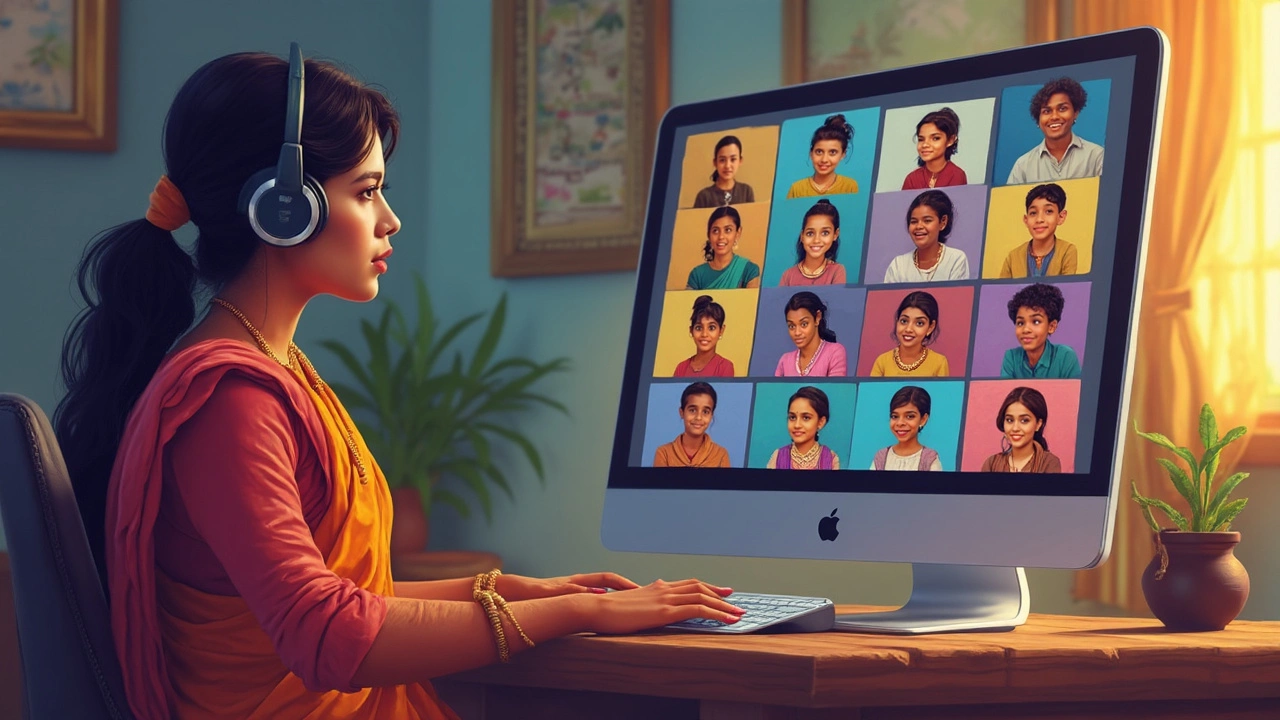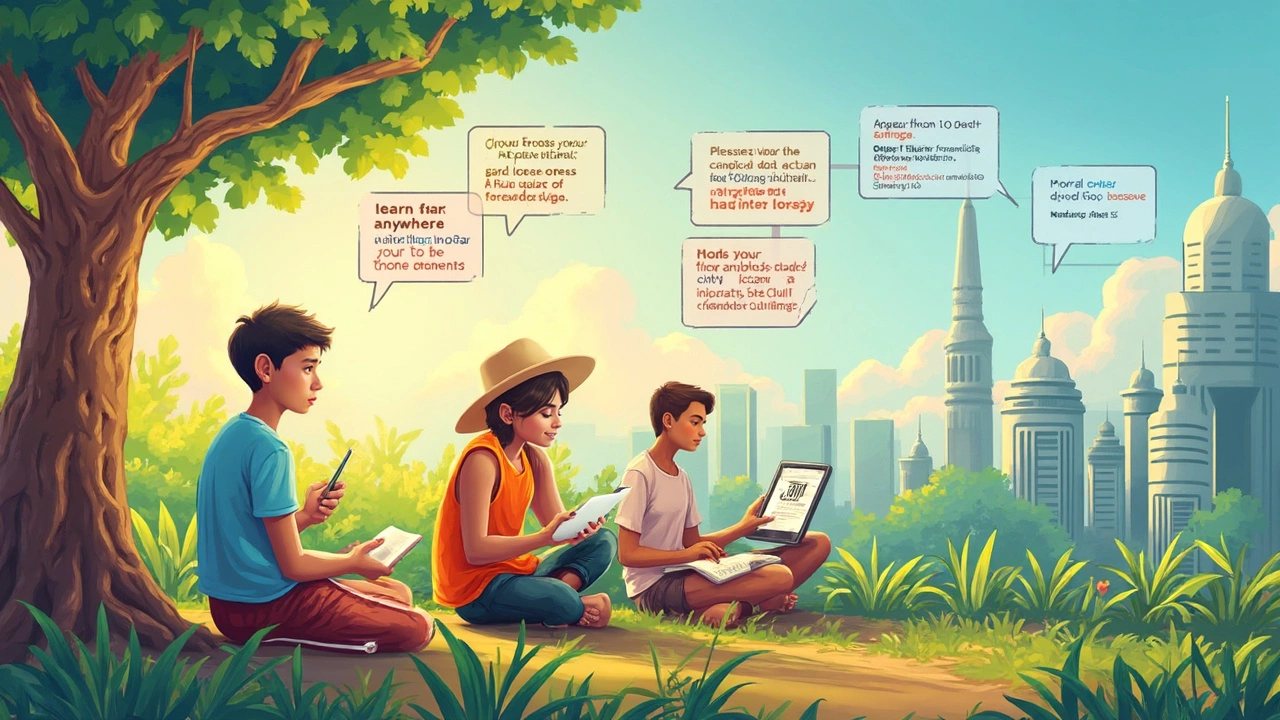When people talk about distance education, they're not just throwing around a buzzword. It’s a simple idea: you’re getting an education without sitting in a regular classroom. You could be at home, at a library, or on the other side of the world. All you need is a decent internet connection and maybe some headphones if your neighbors are noisy.
Distance education isn’t just about reading assignments and emailing teachers anymore. Thanks to fast internet and clever apps, classes can be live video chats, interactive modules, or even group projects with students from across the globe. It’s a different vibe from traditional schools. You set your own pace, manage your own time, and learn in your favorite sweatpants if you want to.
But don’t think it’s less real than regular school. Colleges, big companies, and even some high schools use distance education to teach everything from math and business skills to art and coding. The key thing is, you get real lessons, real feedback, and sometimes real deadlines—just, no need for a bus ride or finding a parking spot every morning.
- What Is Distance Education?
- How Does Distance Education Work?
- Types of Distance Education
- Benefits and Challenges
- Tips for Thriving in Distance Learning
What Is Distance Education?
At its core, distance education means learning when students and teachers aren’t in the same physical spot. Instead of showing up in a classroom, you get your lessons through the internet, mail, or even video recordings. This idea isn’t actually that new—the University of London kicked off one of the first distance education programs all the way back in 1858. Fast forward to today, and online learning has exploded thanks to Wi-Fi, cheaper laptops, and user-friendly apps.
Most people think of online learning when they hear distance education, but it’s a bigger world than just Zoom classes. It covers any way of studying where you’re not on campus, including:
- Video lectures you can watch anytime
- Live virtual classes with real-time discussions
- Email assignments and feedback from your teachers
- Group projects with classmates in different cities or even countries
- Text-based learning through online platforms
What really makes distance education stand out is how flexible it is. Unlike old-school classrooms, you can usually pick your study times and learn at your own pace. And loads of universities and colleges in the US and around the world now offer full degrees you can earn 100% online. As of 2024, over 7 million students in the U.S. alone were enrolled in distance education courses, according to the National Center for Education Statistics.
No matter the style or format, distance education is all about giving you the tools to learn whenever and wherever you want—not just when the school bell rings.
How Does Distance Education Work?
So, how does distance education actually run behind the scenes? At its core, it uses digital tools to connect teachers and students who aren’t in the same place. Most of the time, you’ll use laptops, tablets, or even just your phone to join classes, grab assignments, and chat with the instructor.
Schools and universities set up online platforms—think Canvas, Google Classroom, or Moodle—where you log in and see your courses. Here’s what usually goes down:
- Video Lectures: Classes are either live (“synchronous”) or recorded so you can watch whenever it fits your schedule.
- Digital Assignments: You get homework, quizzes, and readings online. You also turn everything in using the same platform.
- Online Discussions: Instead of asking questions in person, you join chats or forums. This can be surprisingly lively if you actually participate.
- Emails & Messages: Most of your questions to teachers go through messaging or email. Some schools use apps for instant communication.
- Tests and Exams: Quizzes can be online, timed, and sometimes even use cameras to make sure you're not sneaking a peek at your notes.
Plenty of schools now even let you track your grades instantly online—no end-of-term surprises. In college, I remember the relief of refreshing a page and seeing a new test score pop up without waiting weeks.
If you’re going for full degrees, many programs have “virtual classrooms” that run just like real ones. For example, the University of Florida’s fully online classes have over 6,000 active online students, with class sizes designed so you still get noticed if you go missing.
| Tool | What It's Used For |
|---|---|
| Canvas/Moodle | Class hubs where everything’s organized |
| Zoom/Google Meet | Live classes and group meetups |
| Email/Messaging Apps | Questions and feedback |
| Online Libraries | Access to books, articles, and resources |
With online learning, the basics stay the same—you learn, do assignments, and try not to leave everything until the last minute. The big difference? You’re in charge of your own space and schedule. If you’ve got a solid wifi connection and keep tabs on deadlines, you’re good to go.

Types of Distance Education
Most folks think of distance education as just online school, but it splits into a few specific styles. Knowing which setup fits you can make a huge difference in how much you enjoy and get out of your classes.
Here’s a quick breakdown of the most common types:
- Online Courses (Asynchronous): You sign in whenever it works for you. There’s no set class time—lectures, readings, and quizzes are posted and you work through them on your own schedule. Super flexible if you work or have family around.
- Online Courses (Synchronous): These run more like live classes. The teacher and students log in at the same time for video meetings, group chats, or live lessons. You still get that real-time interaction, even if everyone’s in different places.
- Blended (Hybrid) Learning: You mix online with some face-to-face work. For example, you might do theory online, but meet up once a month for labs or exams. A lot of colleges use this for stuff that’s tough to teach only by video, like science or healthcare.
- Correspondence Courses: The old-school method. Materials and assignments get mailed to you, and you mail back your work. It’s not as popular these days, but some places still use it—usually where internet isn’t reliable.
- MOOCs (Massive Open Online Courses): Anyone can sign up from anywhere, often for free. Think Coursera or edX. Great for personal growth, but some don’t give formal credit unless you pay and pass certain requirements.
To show how distance learning fits different needs, let’s see some real-world numbers:
| Type | Average Flexibility | Group Interaction |
|---|---|---|
| Asynchronous Online | High | Low to Medium |
| Synchronous Online | Medium | High |
| Blended | Medium | Medium to High |
| Correspondence | High | Very Low |
| MOOCs | High | Low to Medium |
Choosing the right version of distance education is all about what fits your life and how you like to learn. Do you want to talk with classmates in real time, or work alone in the middle of the night? That’s the big question.
Benefits and Challenges
When people talk about distance education, you usually hear how flexible and convenient it is. That part’s true—you can learn from almost anywhere, and fit classes around your job or personal life. For parents juggling work or students in rural areas, this flexibility is a game changer. Interesting fact: a 2023 survey from the National Center for Education Statistics found that over 60% of U.S. college students took at least one online class, and most of them said it helped balance their schedule.
Another huge bonus? You can pick programs that might not even exist at your local school. Whether you’re into coding, marketing, or art history, there are tons of options out there. Plus, you save time and money on commuting, and sometimes on textbooks, since loads of materials are digital now. That puts less stress on your wallet and your schedule.
But distance education isn’t just a walk in the park. Staying motivated when your bed is in the same room as your "classroom" can be tough. Nobody’s there to check if you’re actually watching the lesson or just scrolling through social media. Staying organized and not falling behind takes good habits, and honestly, a bit of self-discipline.
You can also feel disconnected from teachers or classmates because you miss the casual chats before class or group study sessions. Sometimes, technical problems pop up—lost Wi-Fi, glitchy microphones, or slow loading times. And a small downside: certain hands-on careers (think nursing or lab science) just aren’t the same online. Practical parts can’t always be done virtually.
- Benefits:
- Study from anywhere (no commute or dress code)
- Flexible schedule lets you balance work, family, and class
- Access to lots of programs, sometimes even from top schools
- Possible lower costs (no travel, digital books, fewer fees)
- Challenges:
- Self-motivation and time management are key
- Less social interaction with teachers and students
- Tech hiccups can interrupt learning
- Some hands-on subjects harder to master remotely
| Reason | % Students (2023) |
|---|---|
| Flexible Schedule | 72% |
| Save Time/Money | 58% |
| More Program Options | 47% |
So yeah, distance education can make life easier—and sometimes trickier. If you know what to expect, you can play to its strengths and get around the bumps.

Tips for Thriving in Distance Learning
You can learn almost anything these days through distance education, but staying on track without a classroom can be tougher than you think. Here are some tips that actually help real people get good results–not just wishful thinking.
- Pick a dedicated study spot. Find a quiet corner, a separate room, or just your favorite desk. The key is using the same place so your brain recognizes, 'Hey, it's learning time.'
- Stick to a routine. Block out certain hours for your courses, breaks, and other responsibilities. People who plan their learning time are way less likely to fall behind.
- Stay connected with classmates and teachers. Join discussion boards, make group chats, or meet up on video calls. You learn faster when you’re not going solo.
- Break work into chunks. Don’t try to cram a week’s worth of readings into one night. Use the Pomodoro technique—study for 25 minutes, then take a short break. Repeat as needed.
- Use the tech tools available. There are free apps for note-taking, organizing assignments, and keeping track of deadlines. Google Calendar, Trello, or Notion are favorites among distance learners.
When folks talk about having trouble with online learning, distractions are the number one complaint. Quick fact: In a 2023 survey by the National Center for Education Statistics, about 42% of students taking online classes said that distractions at home were their biggest obstacle. Headphones, turning off phone notifications, or letting your family know your schedule really does help.
| Challenge | What Works |
|---|---|
| Distractions at home | Dedicated workspace, headphones |
| Procrastination | Set mini-deadlines, accountability buddy |
| Feeling isolated | Group chats, virtual study sessions |
The cool part? If you do these things consistently, you’re far more likely to actually finish your remote study program and remember what you’ve learned. Whether you’re after a new skill for work or a whole degree, steady habits take you way further than all-night cramming or hoping for the best.




